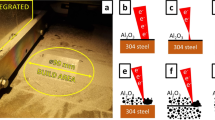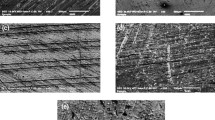Abstract
HfB2 and (ZrB2 + HfB2)-based ceramics containing 19.5 vol% SiC particulate were developed from commercially available powders by hot-pressing. With the assistance of 3 vol% HfN as sintering aid, after hot-pressing at 1900 °C and 50 MPa of applied pressure, full density in both the composites was successfully achieved. The materials revealed a homogeneous microstructure, characterized by faceted diboride grains (2 μm average size) and SiC particles regularly dispersed. Limited levels of secondary phases were found. The thermomechanical properties of the composites were promising: about 22 GPa microhardness and 500 GPa Young’s modulus for both. The HfB2-SiC composite showed values of strength of 650 ± 50 and 465 ± 40 MPa at 25 and 1500 °C, respectively. Likewise, the (ZrB2-HfB2)-SiC composite exhibited values of strength of 765 ± 20 and 250 ± 45 MPa at 25 and 1500 °C, respectively. The excellent response at high temperature in air was attributed to the refractoriness of the phases constituting the composites and to the resistance to oxidation enhanced by the presence of the SiC particulate.
Similar content being viewed by others
References
M. Opeka, I.G. Talmy, E.J. Wuchina, J.A. Zaykoski, and S.J. Causey: Mechanical, thermal and oxidation properties of refractory hafnium and zirconium compounds. J. Eur. Ceram. Soc. 19, 2405 (1999).
K. Upadhya, J-M. Yang, and W.P. Hoffmann: Materials for ultrahigh temperatures structural applications. Am. Ceram. Soc. Bull. 58, 51 (1997).
S.R. Levine, E.J. Opila, M.C. Halbig, J.D. Kiser, M. Singh, and J.A. Salem: Evaluation of ultra high temperature ceramics for aeropropulsion use. J. Eur. Ceram. Soc. 22, 2757 (2002).
R. Loehman. Ultrahigh-temperature ceramics for hypersonic vehicle applications. Industial Heating, January (2004).
C.R. Wang, J-M. Yang, and W.P. Hoffmann: Thermal stability of refractory carbide/boride composites. Mater. Chem. Phys. 74, 272 (2002).
A.L. Chamberlain, W.G. Fahrenholtz, G.E. Hilmas, and D.T. Ellerby: High-strength zirconium diboride-based ceramics. J. Am. Ceram. Soc. 87, 1170 (2004).
J.D. Bull, D.J. Rasky, and J.C. Karika: Stability characterization of diboride composites under high velocity atmospheric flight conditions. In 24th Int. SAMPE Technical Conference (Toronto, Canada, lOct. 20–22, 1992), pp. T1092–1106.
J.J. Melendez-Martines, A. Dominguez-Rodriguez, F. Monteverde, C. Melandri, and G. de Portu: Characterization and hightemperature mechanical properties of zirconium boride-based materials. J. Eur. Cer. Soc. 22, 2543 (2002).
S-K. Woo, I-S. Han, H-S. Kim, E-S. Kang, J.H. Yang, and C-H. Kim: Sintering of zirconium diboride through Fe-based liquid phase. J. Kor. Ceram. Soc. 33, 259 (1996).
F. Monteverde and A. Bellosi: Effect of the addition of silicon nitride on sintering behaviour and microstructure of zirconium diboride. Scripta Mater. 46, 223 (2002).
H. Pastor: Metallic borides: Preparation of solid bodies—sintering methods and properties of solid bodies, in Boron and Refractory Borides, edited by V.I. Matkovich, (Springer Verlag, New York, NY, 1997), pp.457–493.
G-J. Zhang, Z-Y. Deng, N. Kondo, J-F. Yang, and T. Ohji: Reactive hot pressing of ZrB2-SiC composites. J. Am. Ceram. Soc. 83, 2330 (2000).
F. Monteverde and A. Bellosi: Advances in microstructure and mechanical properties of zirconium diboride-based ceramics. Mater. Sci. Eng. A 346, 310 (2003).
J. Bull, M.J. White, and L. Kaufman: Ablation resistant zirconium and hafnium ceramics. U.S. Patent No. 5 750 450 (1998).
F. Monteverde and A. Bellosi: Oxidation of ZrB2 based ceramics in dry air. J. Electrochem. Soc. 150, B552 (2003).
J.W. Hinze, W.C. Tripp, and H.C. Graham: The high-temperature oxidation behaviour of a HfB2+20v/o SiC composite. J. Electrochem. Soc. 122, 1249 (1975).
W.C. Tripp, H.H. Davis, and H.C. Graham: Effect of an SiC addition on the oxidation of ZrB2. Am. Ceram. Soc. Bull. 52, 612 (1973).
F. Monteverde and A. Bellosi: Microstructure and properties of a HfB2-SiC composite for ultra-high temperature applications. Adv. Eng. Mater. 6, 331 (2004).
G.R. Anstis, P. Chantikul, B.R. Lawn, and D.B. Marshall: A critical evaluation of indentation techniques for measuring fracture toughness: I, direct crack measurements. J. Am. Ceram. Soc. 64, 533 (1981).
A. Roine: HSC Chemistry for Windows 5.1, Outokumpu Research Oy, Pori, Finland.
W. Lengauer, S. Binder, K. Aigner, P. Ettmayer, A. Guillou, J. Debuigne, and G. Groboth: Solid state properties of group IVb carbonitrides. J. Alloys Compd. 217, 137 (1995).
F. Monteverde, A. Bellosi, and S. Guicciardi: Processing and properties of zirconium diboride based composites. J. Eur. Ceram. Soc. 22, 279 (2002).
R.A. Cutler: Engineering properties of borides, in Engineered Materials Handbook, Vol. 4, edited by S.J. Schneider (ASM International, Materials Park, OH, 1991), pp. 787–803.
S. Baik and P.F. Becher: Effect of oxygen contamination on densification of TiB2. J. Am. Cer. Soc. 70, 527 (1987).
S. Torizuka, K. Sato, H. Nishio, and T. Kishi: Effect of SiC on interfacial reaction and sintering mechanism of TiB2. J. Am. Ceram. Soc. 78, 1606 (1995).
H. Pastor: Titanium carbonitride based hard alloys for cutting tools. Mater. Sci. Eng. A 105, 401 (1988).
D.N. Øvrebø and F.L. Riley: Densification of zirconium diboride, in Conference & Exhibition of 6th ECerS, Extended Abstracts Vol. 2, British Ceramic Proceedings No. 60 (IOM Communications Ltd., London, U.K., 1999), pp.19–20.
H. Wang, Z.Y. Fu, P. Gu, W.H. Wang, and R.Z. Yuan: Mechanical properties and microstructure of TiB2 ceramic influenced by ZrB2 additive. Trans. Non-ferrous Met. Soc. China 12, 909 (2002).
L-H. Li, H-E. Kim, and E.S. Kang: Sintering and mechanical properties of titanium diboride with aluminium nitride as a sintering aud. J. Eur. Ceram. Soc. 22, 973 (2002).
M-J. Pan, P.A. Hoffman, D.J. Green, and J.R. Hellmann: Elastic properties and microstructure behaviour of particulate titanium diboride-silicon carbide composites. J. Am. Ceram. Soc. 80, 692 (1997).
S.K. Mishra, S. Das, and P. Ramchandraras: Microstructure evolution during sintering of self-propagating high-temperature synthesis produced ZrB2 powder. J. Mater. Res. 17, 2809 (2002).
C. Schmalzreid, R. Telle, B. Freitag, and W. Mader: Solid state reactions in transition metal diboride based materials. Z. Metallkd. 92, 1197 (2001).
S. Torquato: Modelling of physical properties of composites materials. Int. J. Solids Struct. 37, 411 (2000).
D. Kalish, E.V. Clougherty, and K. Kreder: Strength fracture mode and thermal stress resistance of HfB2 and ZrB2. J. Am. Ceram. Soc. 52, 30 (1969).
J.B. Quinn and G.D. Quinn: Indentation brittleness of ceramics: A fresh approach. J. Mater. Sci. 32, 4331 (1997).
Q. Yang, W. Lengauer, T. Koch, M. Scheerer, and I. Smid: Hardness and elastic properties of TiCXN1-X, ZrCXN1-X, and HfCX N1-X. J. Alloys Compd. 309, L5 (2000).
G.R. Irwin: Fracture, in Handbuch der Physik. Vol. 6 (Springer- Verlag, Berlin, Germany, 1958), p. 551.
Author information
Authors and Affiliations
Corresponding author
Rights and permissions
About this article
Cite this article
Monteverde, F., Bellosi, A. Efficacy of HfN as sintering aid in the manufacture of ultrahigh-temperature metal diborides-matrix ceramics. Journal of Materials Research 19, 3576–3585 (2004). https://doi.org/10.1557/JMR.2004.0460
Received:
Accepted:
Published:
Issue Date:
DOI: https://doi.org/10.1557/JMR.2004.0460




